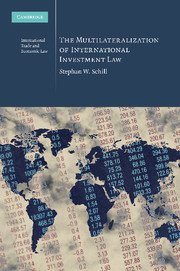Book contents
- Frontmatter
- Contents
- Preface
- List of figures
- Table of treaties, draft instruments, and related documents
- Table of cases
- I Introduction: globalization and international investment law
- II The dynamics of multilateralism and bilateralism in international investment relations
- III Treaty negotiation and multilateralization of international investment law
- IV Multilateralization through most-favored-nation treatment
- V Multilateralization and corporate structuring
- VI Multilateral enforcement of international investment law
- VII Multilateralization through interpretation: producing and reproducing coherence in investment jurisprudence
- VIII Conclusion: multilateralization – universalization – constitutionalization
- Bibliography
- Index
VII - Multilateralization through interpretation: producing and reproducing coherence in investment jurisprudence
Published online by Cambridge University Press: 06 January 2010
- Frontmatter
- Contents
- Preface
- List of figures
- Table of treaties, draft instruments, and related documents
- Table of cases
- I Introduction: globalization and international investment law
- II The dynamics of multilateralism and bilateralism in international investment relations
- III Treaty negotiation and multilateralization of international investment law
- IV Multilateralization through most-favored-nation treatment
- V Multilateralization and corporate structuring
- VI Multilateral enforcement of international investment law
- VII Multilateralization through interpretation: producing and reproducing coherence in investment jurisprudence
- VIII Conclusion: multilateralization – universalization – constitutionalization
- Bibliography
- Index
Summary
Tendencies to a multilateralization of international investment law are also visible in the practice of arbitral tribunals, above all in the way they interpret and construe investment treaties. Unlike their bilateral form suggests, arbitral tribunals do not predominantly interpret and construe BITs according to methods characteristic of the interpretation of bilateral treaties that contain quid pro quo bargains, but employ rationales and argumentative structures that suggest the existence of an overarching body of international investment law that has merely found its expression in bilateral treaty relationships. The dynamics at work in this respect are twofold. On the one hand, investment jurisprudence is reflective of the multilateral aspirations of international investment law that have been outlined above and merely applies them in an already multilateralized environment. On the other hand, the jurisprudence of investment tribunals is proactive in transforming investment law into a multilateral (sub-)system of international law. By multilateralizing investment law through interpretation, arbitral tribunals further develop the aggregate of investment treaties into a functional substitute of a multilateral investment instrument and create overarching linkages between seemingly unconnected treaty relationships. Investment tribunals thus translate the similarities of bilateral treaties, backed by the existing elements of multilateralism, into multilateral reality. They produce and reproduce international investment law as a uniform transnational investment regime.
In order to understand investment law as a multilateral system that exists independently from, and at the same time above, bilateral treaty relations, it is necessary to show that investment tribunals develop coherence in their jurisprudence not only with respect to one bilateral treaty relationship but across various BITs.
- Type
- Chapter
- Information
- The Multilateralization of International Investment Law , pp. 278 - 361Publisher: Cambridge University PressPrint publication year: 2009

